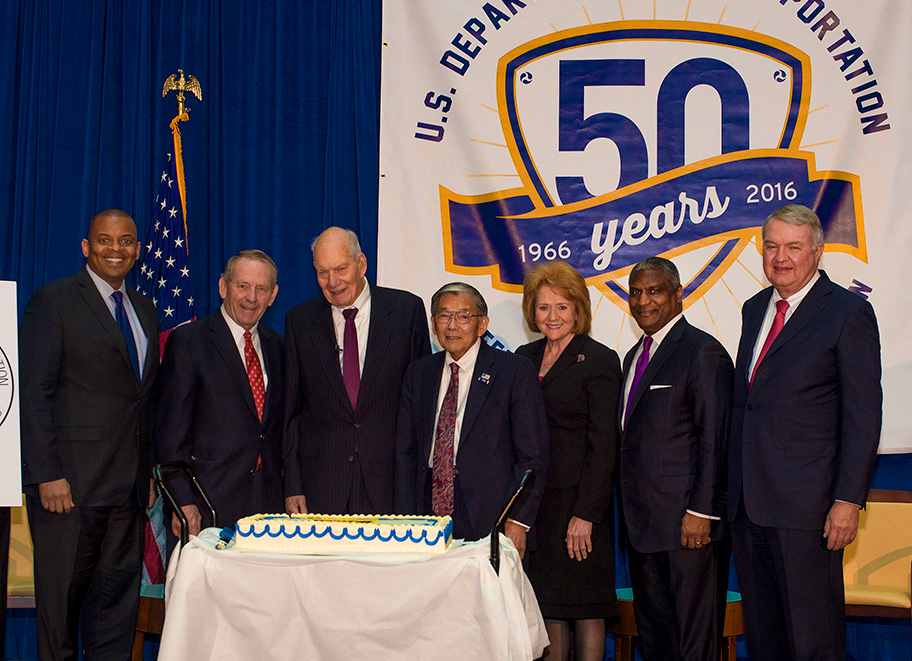In Memoriam: Norman Y. Mineta
14th U.S. Secretary of Transportation
1931 - 2022
by Richard Weingroff / FHWA News 2022
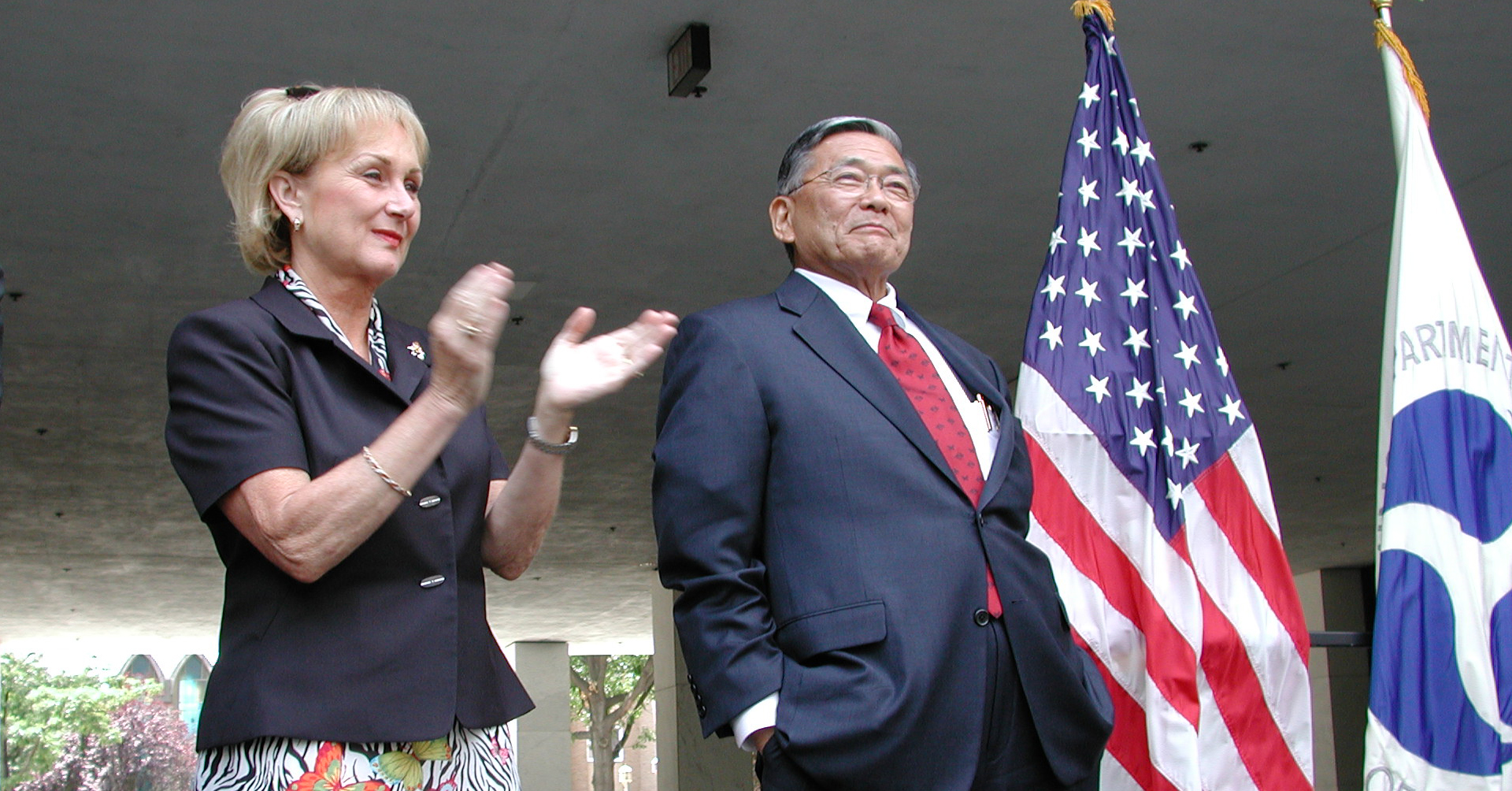
On May 3, 2022, former Secretary of Transportation Norman Y. Mineta died, surrounded by family, at his home in Edgewater, Maryland. In addition to being the longest serving Secretary of Transportation (January 25, 2001-August 7-2006), he had a distinguished lifetime of public service. His death, as current Secretary Pete Buttigieg put it, was "the passing of a great American."
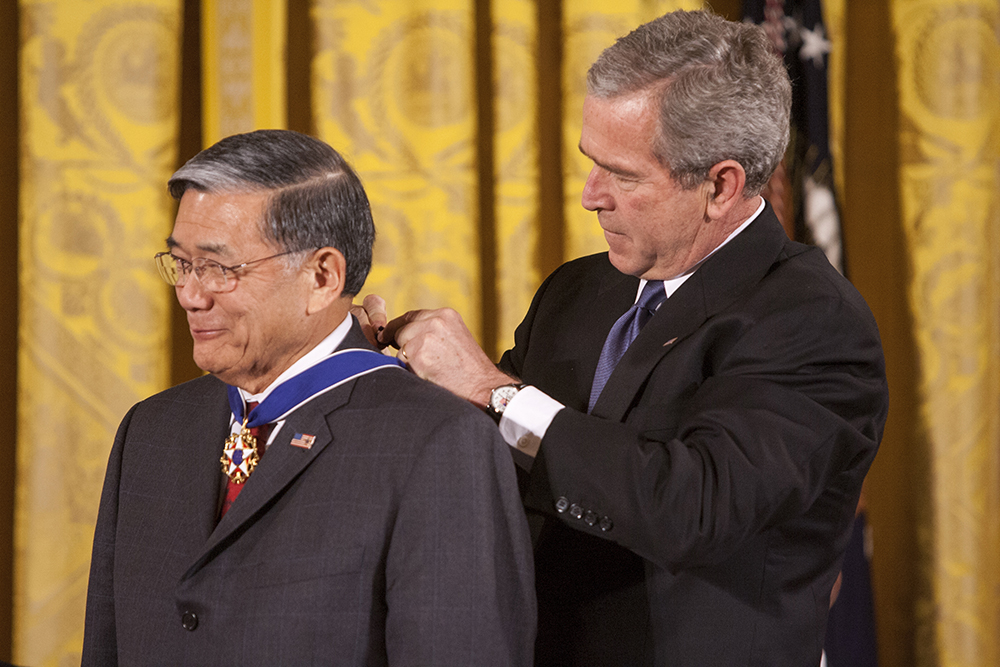
Secretary Mineta, a native of Jan Jose, CA, was born on November 12, 1931. During World War II, his family, including 10-year old Cub Scout Norman, were forced to live most of the war in a Japanese internment camp near Cody, Wyoming. As an adult, he served in the U.S. Army and numerous State and local posts, including as Mayor of San Jose (1971-1974), before winning election in 1974 to the U.S. House of Representatives in the Democratic post-Watergate mid-term elections landslide.
A lifelong Democrat, he was assigned in 1975 to the Committee on Public Works and Transportation and would retain membership. including as chairman (1993-1995), until retiring from the House in October 1995. During his years in the House, he was involved in developing periodic surface transportation reauthorization Acts, including the landmark post-Interstate legislation, the Intermodal Surface Transportation Efficiency Act of 1991. Throughout these years, he was known for his bipartisan approach to legislation. He often stated some variation of, "There are no Democratic or Republican highways, no such thing as Republican or Democratic traffic congestion."
In June 1977, he joined with Representative Frank Horton of New York in introducing a House resolution asking President Jimmy Carter to proclaim the first 10 days of May as Asian-Pacific American Heritage Month – Salute to Liberty. Senators Daniel Inouye and Spark Matsunaga, both Japanese Americans from Hawaii, sponsored the resolution in the Senate. The first celebration was observed in 1979. On May 11, 1979, Congressman Mineta was greeted by Secretary of Transportation Brock Adams at DOT Headquarters for the observance. In remarks to DOT employees, Mineta explained, "It is important for Americans of all ages and backgrounds to become familiar with their own heritage. Knowledge of our past provides a better understanding of the present and prepares us for the future." He concluded by sharing his hopes for Asian/Pacific American Week. "Asian-Americans must not shy away from the challenges which still confront us. We must remember that, in spite of gross injustices and prejudice, we have benefitted from the American promise and we must dedicate ourselves to the task of insuring the fulfillment of that promise for future generations . . . . Our challenge is to insure that all Asian/Pacific Americans are presented with an equal opportunity to share in the dream and the promise of their American heritage. We will meet that challenge."
In March 1990, shortly after President George H. W. Bush and Secretary of Transportation Samuel K. Skinner released the national transportation plan titled Moving America, Chairman Mineta of the House Subcommittee on Surface Transportation criticized the plan as giving States "the shift and the shaft." As the resulting bill working its way through Congress, he told the American Road and Transportation Builders' Association in June 1991 that his vision, as reflected in the pending bill, was not more of the same. "America needs more of a transportation vision for the future than endless ribbons of asphalt, overpasses, and off ramps." As for the administration's plan, "I will not stand by and allow Washington to chip away at the foundation of fairness and hurt every city and state in the union," Mineta said. He supported the Administration's proposed "Nickel for America," but only if every penny collected is guaranteed to be spent on transportation. "Anything less will be an outright fraud perpetrated against the American people." He concluded that "America needs nothing less."
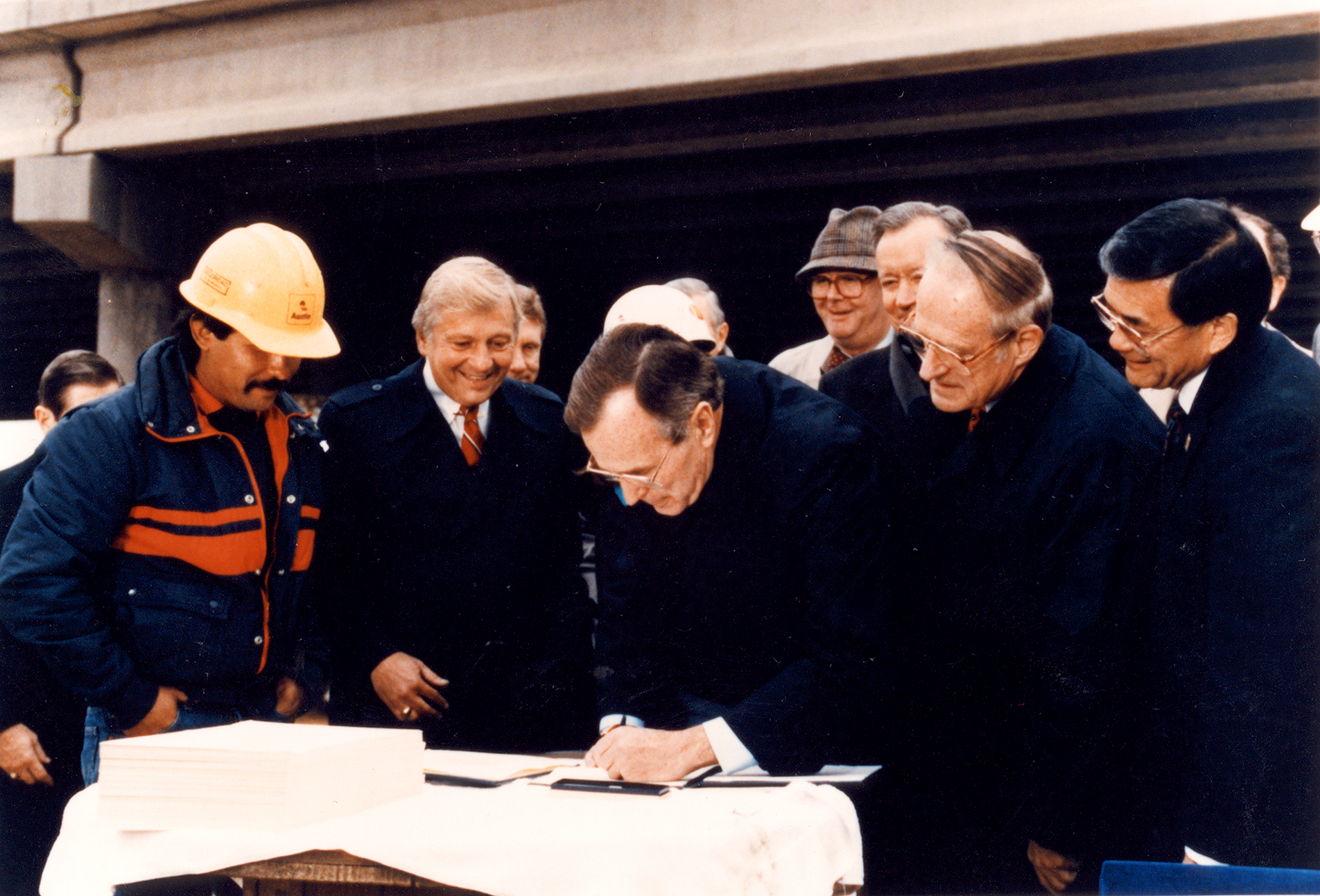
Chairman Mineta was one of the architects of the landmark Intermodal Surface Transportation Efficiency Act of 1991. He was on hand when President George H. W. Bush signed the legislation on December 18, 1991, at a construction site in Texas. From left, construction worker Arnold Martinez, Rep. Bud Shuster, President Bush, Sen. Daniel Patrick Moynihan (in hat), Rep. John Paul Hammerschmidt, Rep. Robert Roe, and Rep. Norman Mineta.
The landmark ISTEA, which remains the foundation of post-Interstate reauthorizations, was the result of difficult negotiations among the Administration, the House, the Senate, and a range of stakeholders, but in the end, Representative Mineta was on hand when President Bush signed the bill in Texas at a State Highway 360 construction site not far from Dallas-Fort Worth International Airport.
On July 29, 1993, Chairman Mineta joined other congressional leaders, Federal Highway Administrator Rodney E. Slater, Eisenhower family members, and others in a ceremony on Capitol Hill to unveil the Eisenhower Interstate System sign, honoring President Dwight D. Eisenhower for his role in launching the Interstate Highway Program. The sign, consisting of five stars and the name "Eisenhower Interstate System" on a blue background, has been installed along many Interstate highways.
In 1993 and 1994, Chairman Mineta focused on what became the National Highway System Designation Act of 1995, with the goal of completing it in 1994 so that earmarks in an appropriation act, which had not been included in an authorization bill, could be added. The bill became embroiled in issues, including whether to retain the 55 mph speed limit, the inclusion of earmarks, ISTEA's requirement on the use of crumb rubber modifier, and outdoor advertising. The session ended before House approval, but Chairman Mineta fully intended to reintroduce and complete the bill in 1995. However, in the mid-term elections of November 1994, Republicans took control of the House and the Senate. When Congress returned in January 1995, Mineta was a former chairman.
He retired from the House in October 1995 and became head of Martin Lockheed's Intelligent Transportation System Division, which was developing electronic toll collection and weigh-in-motion technology.
During his years in the private sector, he remained a champion of civil liberties and worked to secure an official apology for the Japanese Americans who, like his family, had been forced to live in internment camps during World War II. He was part of the group around President Ronald Reagan as he signed the Civil Liberties Act on August 10, 1988. It referred to the internment as "a grave injustice" and formally apologized for the "these fundamental violations of the basic civil liberties and constitutional rights of these individuals of Japanese ancestry on behalf of the Nation."_The law also provided a $20,000 payment to all survivors. In remarks before signing the bill, President Reagan singled out the former Congressman:
Congressman Norman Mineta, with us today, was 10 years old when his family was interned. In the Congressman's words: "My own family was sent first to Santa Anita Racetrack. We showered in the horse paddocks. Some families lived in converted stables, others in hastily thrown together barracks. We were then moved to Heart Mountain, Wyoming, where our entire family lived in one small room of a rude tar paper barrack." Like so many tens of thousands of others, the members of the Mineta family lived in those conditions not for a matter of weeks or months but for 3 long years.
In an oral history for the World War II Museum in New Orleans, Mineta recalled the event. "I think for the Japanese American community, they shouldered the yoke of the evacuation and internment in 1942. And I think that yoke was finally lifted."
In 1991, he founded the Mineta Transportation Institute in partnership with the Lucas College and Graduate School of Business at San Jose State University. Its goal is to increase the safety, efficiency, accessibility, and convenience of our Nation's transportation system.
He returned to government service when President Bill Clinton nominated him to be Secretary of Commerce (July 20, 2000-January 20, 2001).
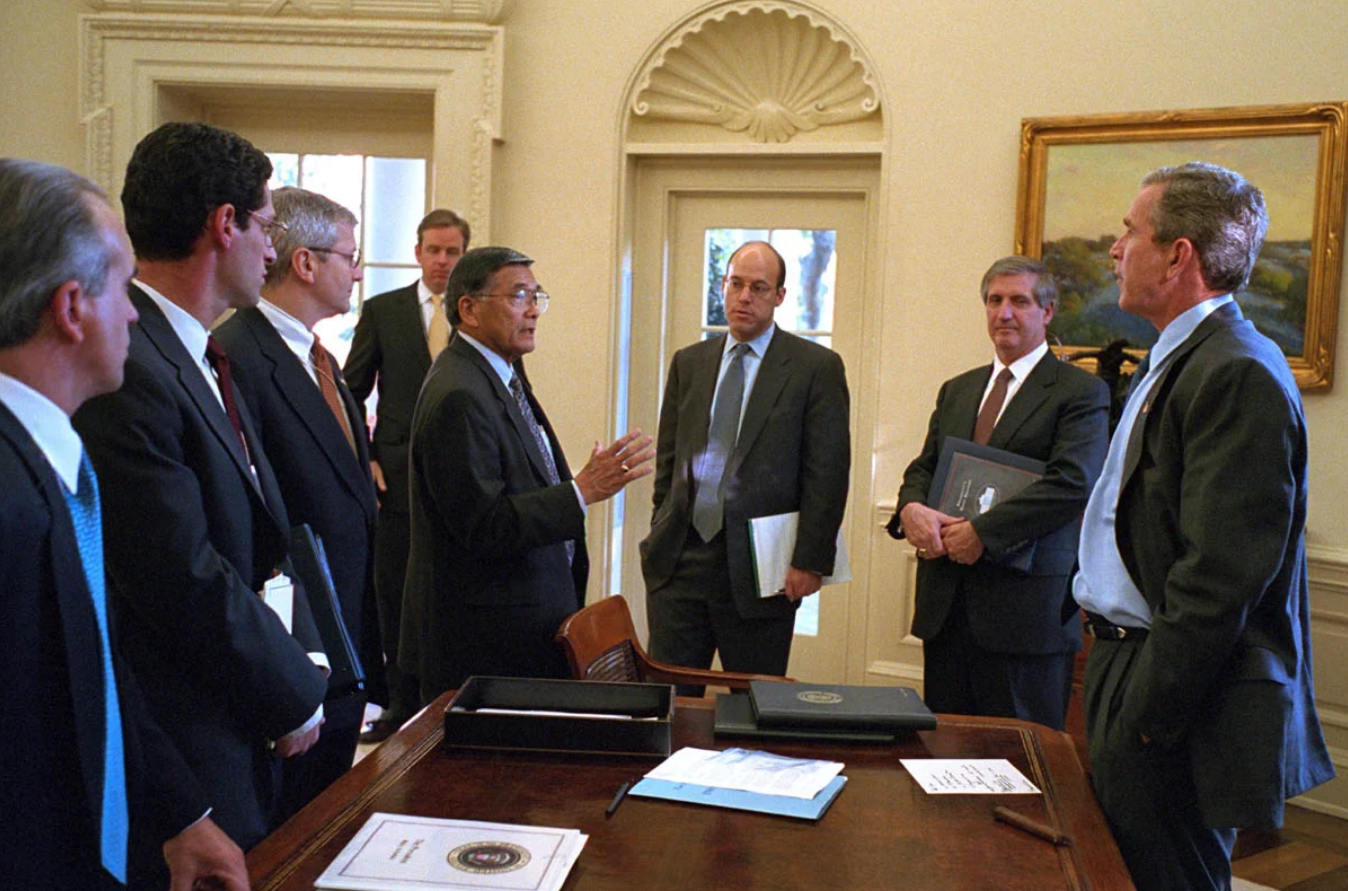
Photo from National Archives and Records Administration.
He was serving in that capacity when President George W. Bush nominated him to be Secretary of Transportation – only the fourth person to serve in the Cabinet under two Presidents of different parties. "Norm made a reputation," President Bush explained, "in the halls of Congress as someone who understands that a sound infrastructure in America will lead to economic opportunity for all Americans." The Senate confirmed the 69-year-old Mineta on January 24, 2001, by a vote of 100-0, while his confirmation hearing before the Senate Committee on Commerce, Science, and Transportation was underway. The Washington Post explained that, "Despite his liberal credentials – he was an honorary chairman of Americans for Democratic Action – Mineta's overarching reputation is as a bipartisan pragmatist whose ideology is to rebuild America's aging transportation infrastructure and to find ways to pay for it."
Following the terrorist attack on September 11, 2001, he and Federal Aviation Administrator Jane F. Garvey, formerly FHWA's Deputy Administrator (1993-1997), oversaw the closing of the country's airspace, as well as its reopening a few days later. In 2005, he was instrumental, along with many FHWA officials, in restoring transportation to the New Orleans areas after Hurricane Katrina. He implemented the Safe, Accountable, Flexible, Efficient Transportation Equity Act: A Legacy for Users (SAFETEA-LU) and created the Research and Innovative Technology Administration and the Pipeline and Hazardous Materials Safety Administration.
Following the 9/11 attack, Secretary Mineta was responsible for creating the Transportation Security Administration (TSA), which was part of DOT before shifting to the Department of Homeland Security in 2003. In a 2009 interview, he replied to a question about his greatest accomplishment:
My greatest accomplishment was setting up the Transportation Security Administration, meeting the 36 mandates in the law creating the agency, and doing it within the prescribed time frame. The biggest mandate was establishing security operations at all U.S. commercial airports by November 17, 2002. What many people don't realize is that, when completed, the TSA was the largest single mobilization of any workforce since World War II.
Following his death, TSA released a statement recalling that he "worked tirelessly" on the "monumental effort" to establish TSA. He was an "inspirational leader" who long after he left office, "participated in TSA events over the years and attended our 2018 annual awards ceremony where he presented the inaugural Norman Y. Mineta Leadership Award, TSA's highest honor." The statement added, "We feel his presence every day in performing our critical mission to protect our transportation system. We continue our work in honor of his legacy and extend our heartfelt condolences to his wife, Deni, and the entire Mineta family."
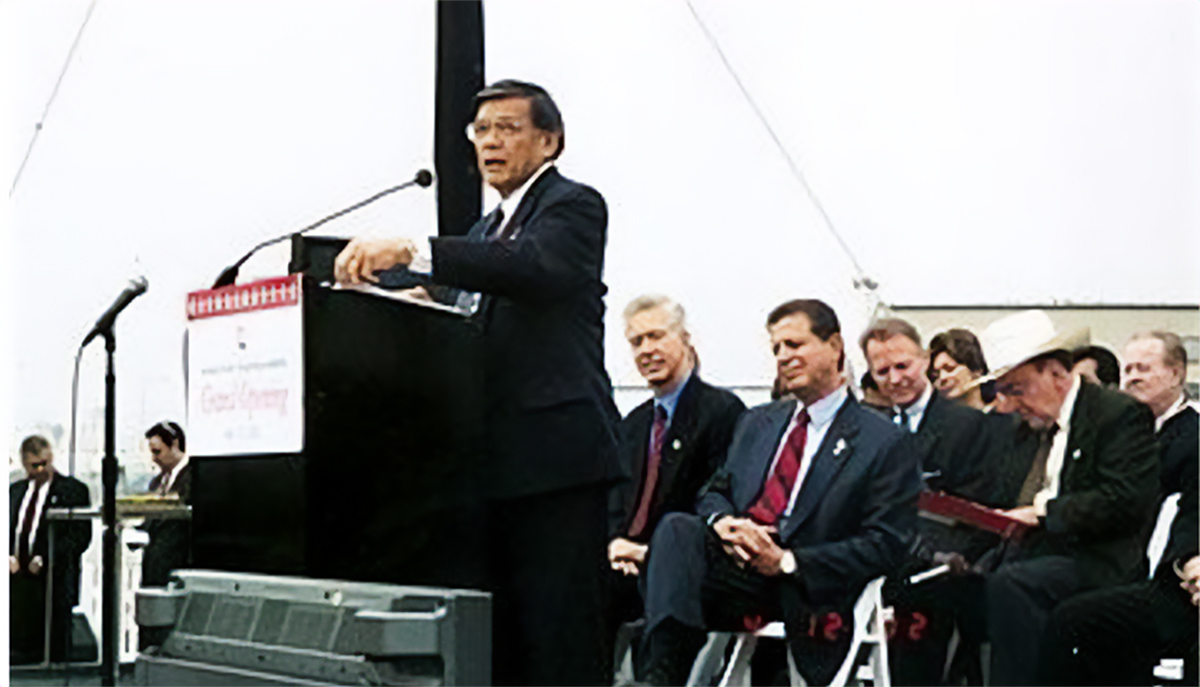
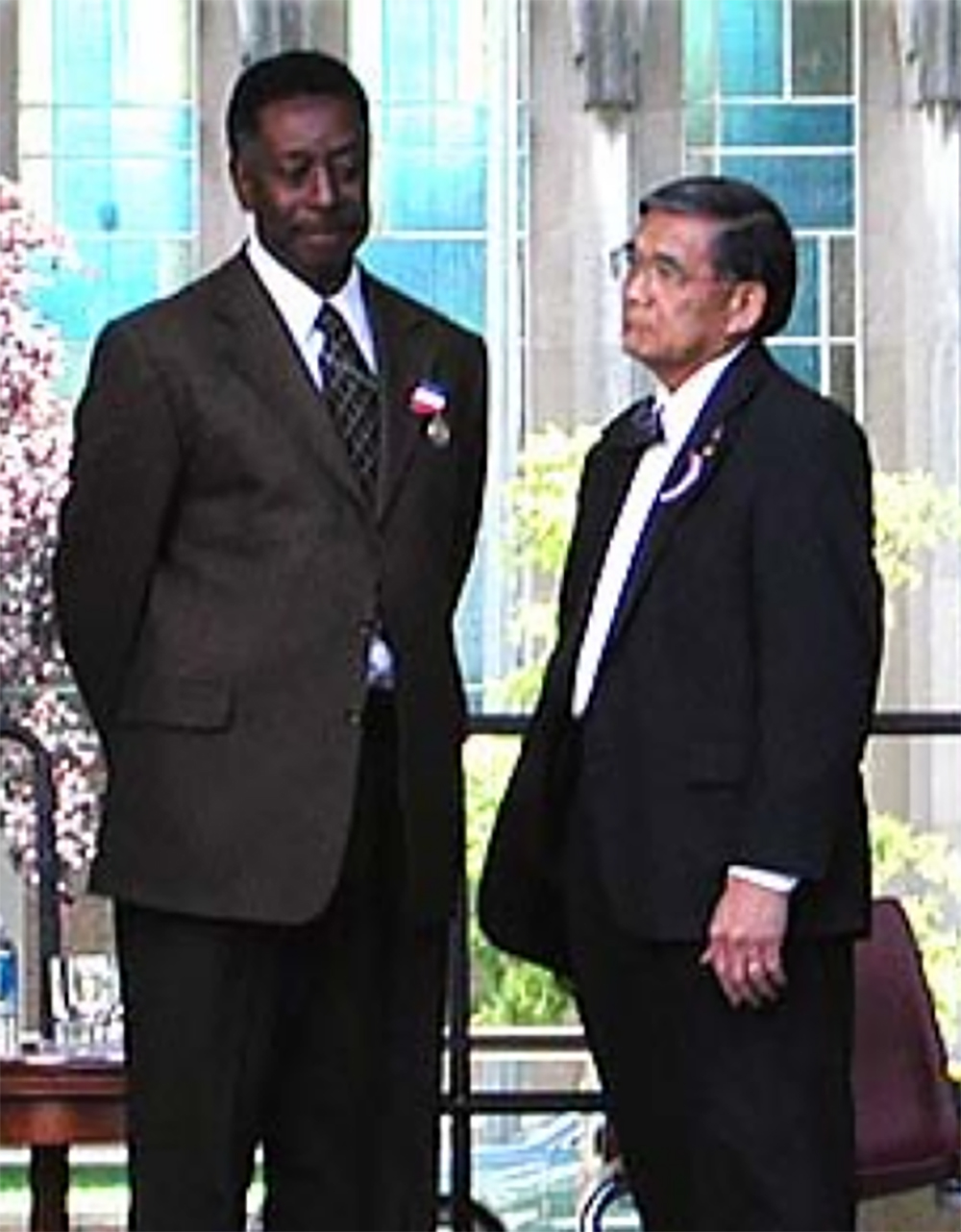
In September 2002, Secretary Mineta presented the initial Transportation 9-11 Medals in a ceremony commemorating the 9/11 attack. One of the medals went to Arthur Hamilton, Associate Administrator for Federal Lands Highway for his efforts as co-chair of the the FHWA/FMCSA Emergency Preparedness and Response Team, which assisted State DOTs in reviewing security and operations plans, conducting risk assessments of their critical infrastructure and assessing appropriate countermeasures against future attacked. In 2003, he presented the Transportation 9/11 Medal to the New York Division Office (Division Administrator Robert Arnold, Richard Backlund, Richard Beers, Jr., David Hart, Thomas Herritt, Jr., Jonathan McDade, and Arthur O'Connor.) Numerous FHWA employees received Transportation 9/11 Ribbons.
His biggest disappointment, by the way, related to surface transportation funding. In 2001, he twice went to the White House to lay out his plans for the next 6-year surface transportation program reauthorization proposal, initially with an increase in the gas tax and later with a Consumer Price Index inflator on the existing gas tax. In both cases, President Bush rejected the proposal. "Norm," he said of the first proposal, "I don't want any of those tax increases. Get those out." Mineta said the result was that not long after SAFETEA-LU passed in 2005 without a new funding source, "the administration asked for an $8 billion infusion of general funds into the Highway Trust Fund so it wouldn't be running a deficit in 2007."
His interactions with FHWA were numerous and varied. On May 14, 2001, he was in Utah for ceremonies marking completion of the I-15 reconstruction project. Utah, he said, had "transformed an old, decaying roadway into a safe, high-quality, 12-lane superhighway that is engineered to meet the needs of citizens along the Wasatch Front for the next 50 years." He was the keynote speaker on April 12, 2002, for the opening of California's Alameda Corridor, a $2.4 billion intermodal project to speed the flow of trade. In May 2005, during a five-State tour during National Transportation Week, he stopped in Tallahassee, Florida, to join Federal Highway Administrator Mary E. Peters and Governor Jeb Bush to announce $928 million in Emergency Relief Program funds to repair road and bridge damage from the 2004 hurricanes.
During a ceremony on September 11, 2002, he presented the first Transportation 9-11 Medals to DOT officials, including FHWA's Arthur Hamilton in honor of his efforts as co-chair of the FHWA/FMCSA Emergency Preparedness and Response Team. After the Senate confirmed Deputy Administrator J. Richard Capka as Federal Highway Administrator, Secretary Mineta administered the oath of office on May 31, 2006, two weeks ahead of his ceremonial swearing in ceremony.
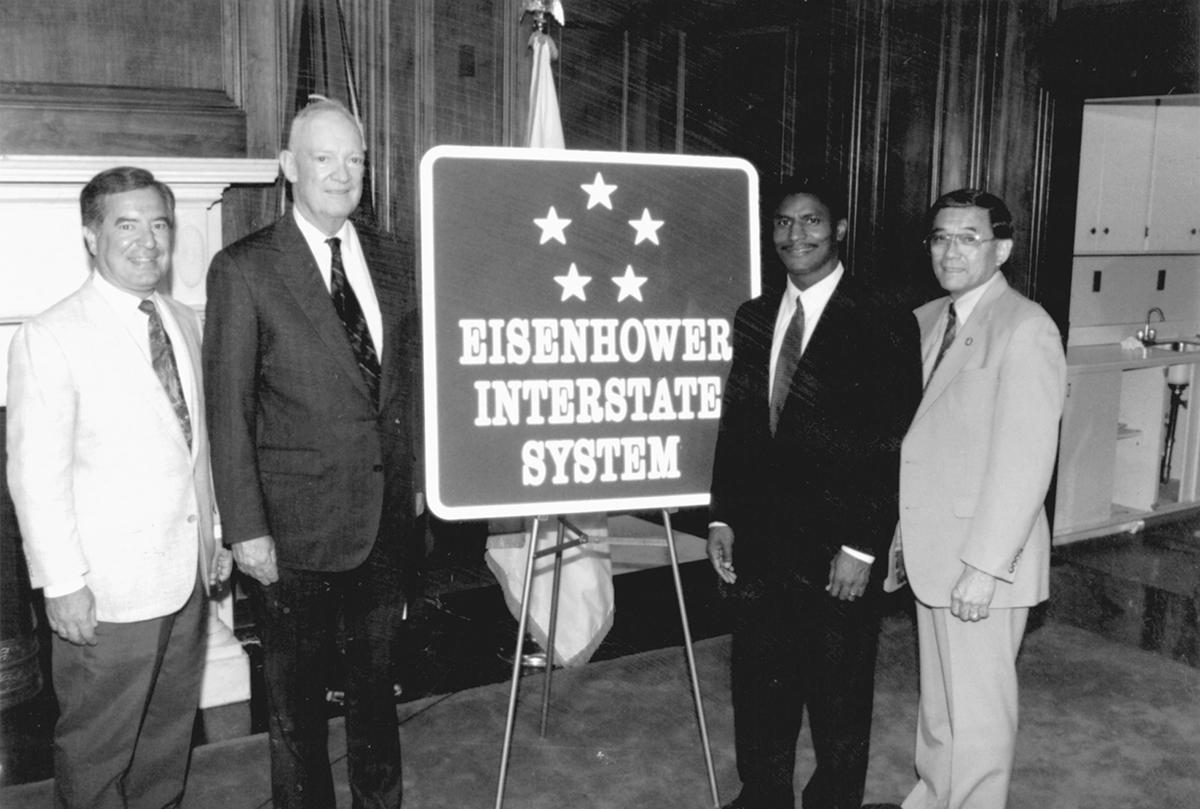
Secretary Mineta provided a greeting to FHWA's Website celebrating the 50th anniversary of the Interstate System:
"The Interstate highway system is essential to America's prosperity and way of life. Since its beginning 50 years ago, the Interstate network has provided a vital link for connecting goods to markets here and around the world and bringing together people from our nation's cities, towns and rural communities . . . . This milestone is an opportunity to celebrate the Interstate system's contribution to our economic strength, recognize the men and women whose leadership and hard work created it, and work to ensure that it remains strong, safe and efficient for the future."
Not long after the anniversary, DOT held a farewell ceremony on July 7, 2006, for outgoing Secretary Mineta, then 74, in the courtyard of DOT's former headquarters building. In his 25-minute address, delivered with "a tremendous, weighty heart," he touched on many subjects, including the events of 9/11. But he really wanted to thank DOT's employees. "I just can't get over all of you taking time from your own lunch to be here. I just want to thank each and every one of you for your great work. When I think about all the things we've gone through . . . we've dealt with man-made disaster and we've dealt with natural disasters and we have – through you – responded to every one of them." He added, "This was a great ride, and I fed off your dedication and passion."
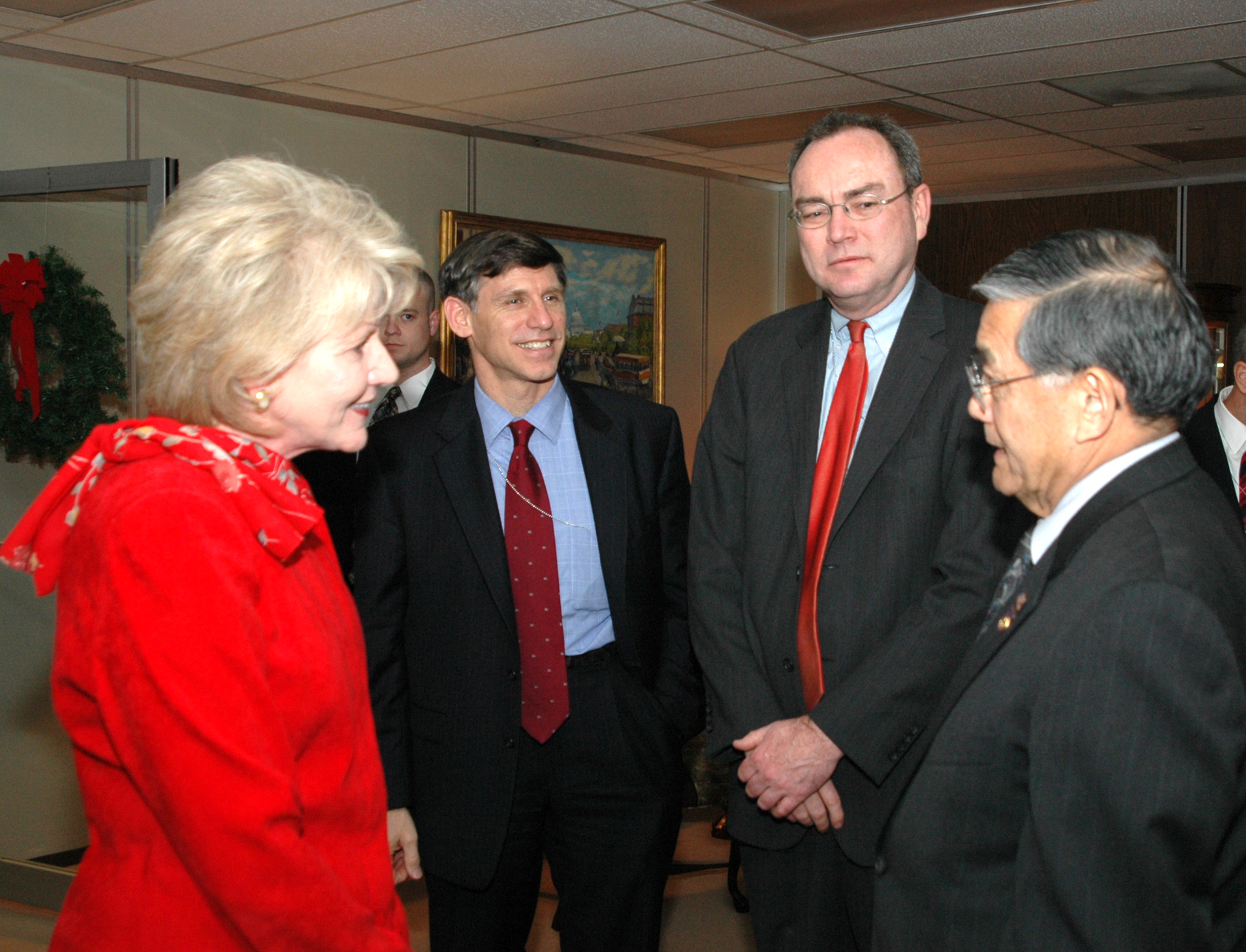
As might be expected, the former Member of Congress and two-time Cabinet Secretary received many honors in his life, a few of which will be cited here. In November 2001, for example, his hometown airport was renamed the Norman Y. Mineta San José International Airport. President Bush presented the Presidential Medal of Freedom, the country's highest honor for civilians, to Secretary Mineta on December 15, 2006. "No Secretary of Transportation," the President said, "ever served longer, or confronted greater challenges, than Norm Mineta." His life was "an example of leadership, devotion to duty, and personal character." On September 15, 2008, a portion of the West Valley Freeway (SR 85) in the San José area was named the Norman Y. Mineta Highway.
In 2016, former Secretary Mineta joined the committee conducting the Future Interstate Study authorized by Section 6021 of the Fixing America's Surface Transportation Act of 2015. Executive Director Thomas D. Everett, then Associate Administrator for Infrastructure, was FHWA's principal contact to the committee. The study, conducted by the Transportation Research Board, released its findings in December 2018 and offered recommendations to "restore the system's premier status within the nation's highway program in a manner that is aggressive and ambitious, although by no means novel."
In response to his death, former President Bush said that Mineta's life was "a wonderful American story about someone who overcame hardship and prejudice to serve in the United States Army, Congress, and the Cabinet of two Presidents. As my Secretary of Transportation, he showed great leadership in helping prevent further attacks on and after 9/11. As I said when presenting him with a Presidential Medal of Freedom, Norm has given his country a lifetime of service, and given his fellow citizens an example of leadership, devotion to duty, and personal character."
Secretary Buttigieg recalled Secretary Mineta's "outreach around the time I was settling into the job of Secretary, mindful of the high standard set by those who had held the office before, and encouraged by the stories he shared with me about his confirmation process and his tenure at the Department." He concluded:
My thoughts today are with Secretary Mineta's family, as well as with those of you at DOT who've lost a friend and mentor – and those who, inspired by his example, continue to dedicate your lives to making this country a better place.
